Imagine a world without dinosaurs, but where a diverse bunch of marine alternatives had their celebrity status instead. This is a world that did exist over 175 years ago. The word dinosaur and the scientific concept of dinosaurs as a group of extinct animals was not invented until 1842. Before then, the discovery of many remarkable marine reptile fossils, especially ichthyosaurs, captivated the public imagination in the way that dinosaurs do today (Figure 1).
Ichthyosaurs – icons of evolution
Ichthyosaurs are one of the most iconic of all fossils. Their remains are preserved in rocks from the late Early Triassic period (~250 Ma) through to the early Late Cretaceous (~90 Ma). Although often called “swimming dinosaurs” – a real pet hate of mine – ichthyosaurs were in fact a group of fully aquatic marine reptiles – and not dinosaurs. Practically every palaeontological collection in the world contains an ichthyosaur fossil – at the very least an isolated vertebra, but often an isolated fin, skull or even a whole skeleton. Failing that, replicas of skeletons (in the form of casts) also populate many collections. In fact, I type this surrounded by ichthyosaur bones, teeth and casts on my desk.

At the beginning of the 19th century in particular, there was a major interest in ichthyosaurs. Everybody wanted one for their collection. This was largely due to the efforts of Mary Anning (1799-1847), a palaeontologist who lived in the coastal town of Lyme Regis, situated in Dorset on the south coast of England.
Lyme Regis is seen often as the birthplace of ichthyosaurs as the very first specimens brought to the attention of the scientific world were found there. Ichthyosaur fossils had, of course, been discovered for many years before but were not truly recognised for what they were. The first illustrations of what we can today reliably identify as ichthyosaur fossils were actually reported in 1699, but these, like several early finds, were identified as fish. Most other early finds were usually regarded as “crocodiles”. In fact, the first scientific account of an ichthyosaur dates back to 1814. This was of a large skull and partial skeleton collected by Mary and her brother, Joseph, and which formed a scientific study by Sir Everard Home – the first-ever scientific description of an ichthyosaur (Figure 2). This was a monumental moment.
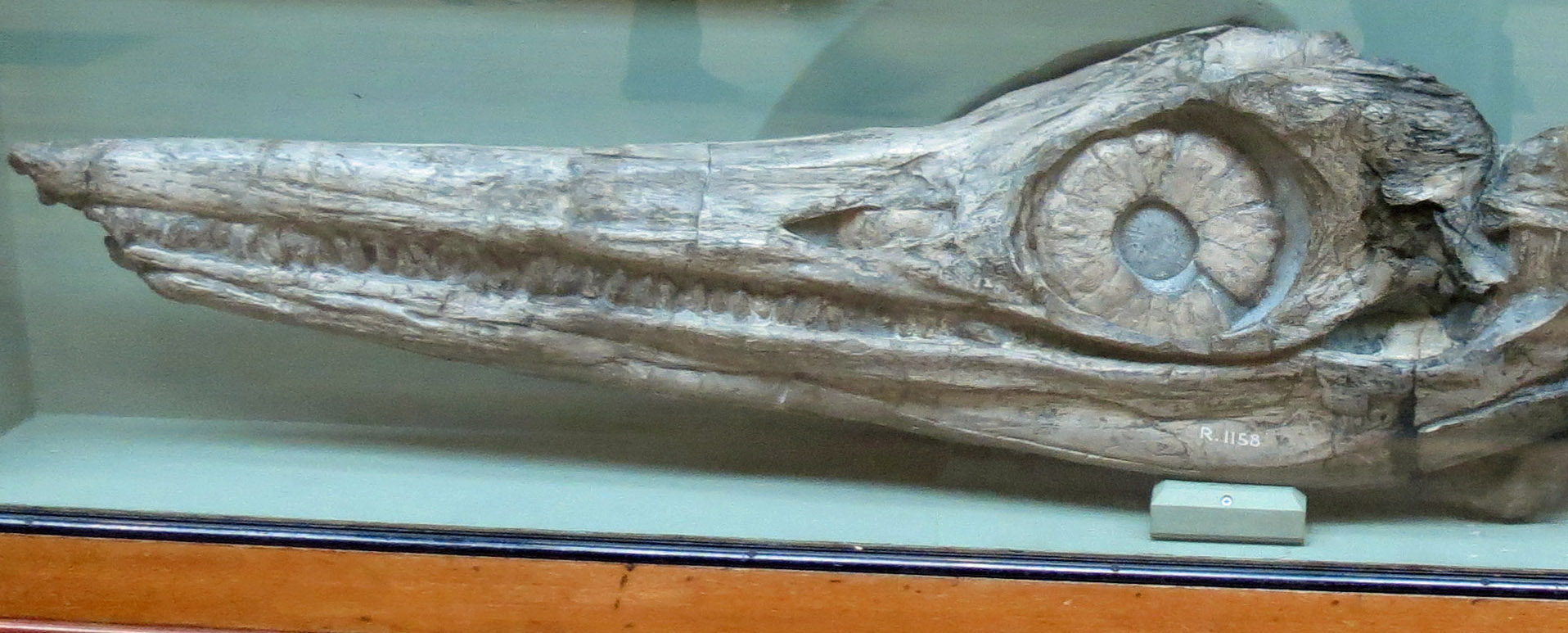
The discovery of complete fossilised skeletons around Lyme Regis was a turning point for the new science palaeontology. Ichthyosaurs rose up from the depths of time and provided us with a snapshot of just how alien our world once was. They became a global sensation. Even several large concrete ichthyosaur models were erected in Crystal Palace Park, London, alongside dinosaurs and other prehistoric animals in 1854 and can – amazingly – still be seen today (Figure 3).
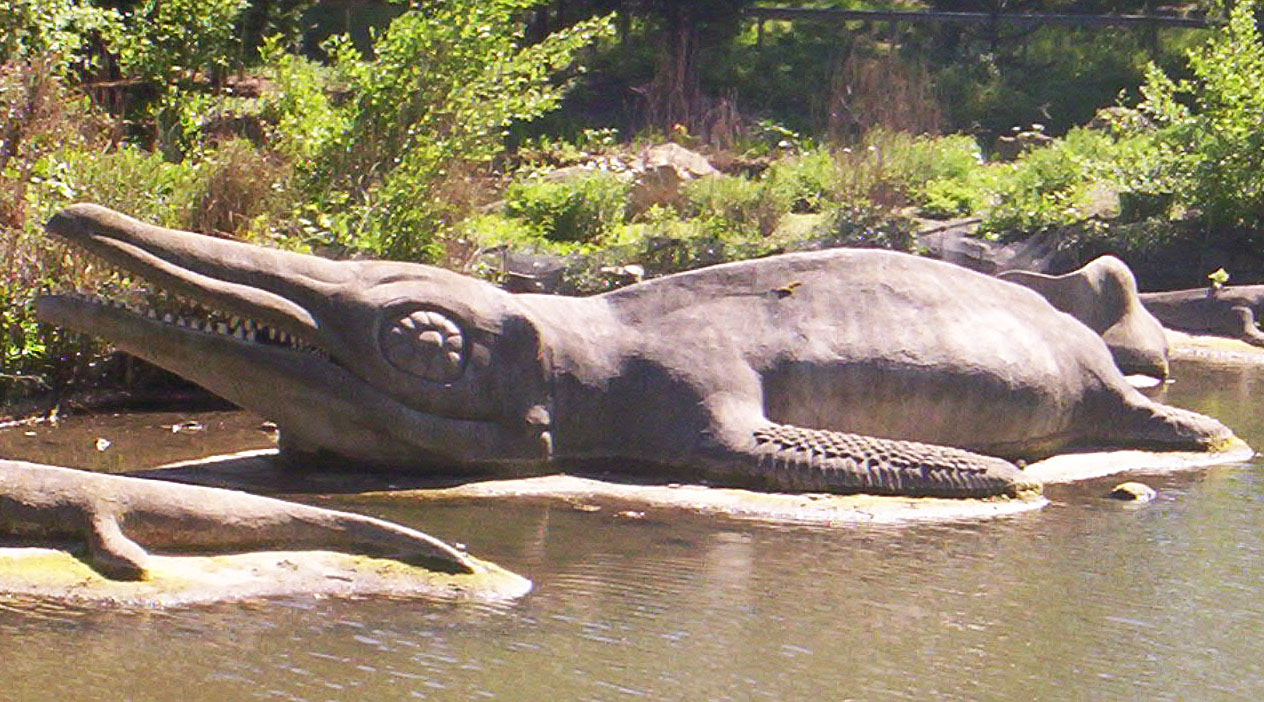
As the industrial revolution spread through the country at the same time as Mary Anning was making such finds famous, specimens were being discovered at an ever increasing rate in the UK, from beach exposures, quarries, and railway cuttings to underground mines. Since these first discoveries, specimens began to popup everywhere. Thousands upon thousands of specimens have been found globally, from the Triassic through to the Cretaceous, and more than 100 species are now known. These fossils have provided the basis for many scientific studies and ultimately two centuries of research.
In 2003, two leading ichthyosaur experts, Christopher McGowan and Ryosuke Motani, published a very useful book on ichthyosaur studies. Colloquially known by ichthyosaur researchers as the “orange bible”, due to the bright orange cover, this handbook compiled what was then known about ichthyosaurs. However, in just 15 years since its publication things have changed so much that the book, although still an excellent reference for any ichthyosaur worker, is already dated. That is science, after all. Once something is published it soon becomes out of date. New discoveries are being made at an alarming rate and our knowledge is constantly changing and updating. There are more ichthyosaur researchers in the world today than there have ever been before. It is an exciting time to study ichthyosaurs right now.
Origins as “lizards with flippers”
Life on Earth began in the oceans more than three billion years ago and it was in this marine environment where the first animals evolved. Every single animal, living and extinct, is therefore a descendant of a marine animal. This is important to note in the story of ichthyosaurs because they are secondarily aquatic animals meaning that their ancestors were land-dwellers that had descended from an ancient fish and evolved to walk on land. It is intriguing to ponder why the ichthyosaur forebear opted to return to the sea. We are not entirely sure of the answer, but there are a couple of plausible explanations. On land, competition was fierce, so exploring a new (or, technically “old”) environmental niche would have been a good way to avoid predators whilst exploiting the rich sources of marine food. Thus, it seemed appropriate to re-enter and take advantage of the watery realms.
A well-documented example of a land-dwelling animal adapting to a marine environment are whales and dolphins, whose ancestors were also running around on land. In fact, like whales and dolphins today, ichthyosaurs actually gave birth to live young in the sea. Interestingly, the viviparity of ichthyosaurs does not seem to have evolved during their adaption to an entirely marine life style but rather seemed to have been present already in their ancestors before they took to the sea . It might seem odd that a reptile would give birth to live young, as opposed to laying eggs like most other reptiles but several living reptiles, including species of snake and skink, bear live young. Evidence for ichthyosaur live birth is found in several specimens around the world, although some of the most beautiful examples have been collected from quarries in and around the town of Holzmaden, Germany (Figure 4). Some have even been found with more than 10 individual embryos preserved inside them.
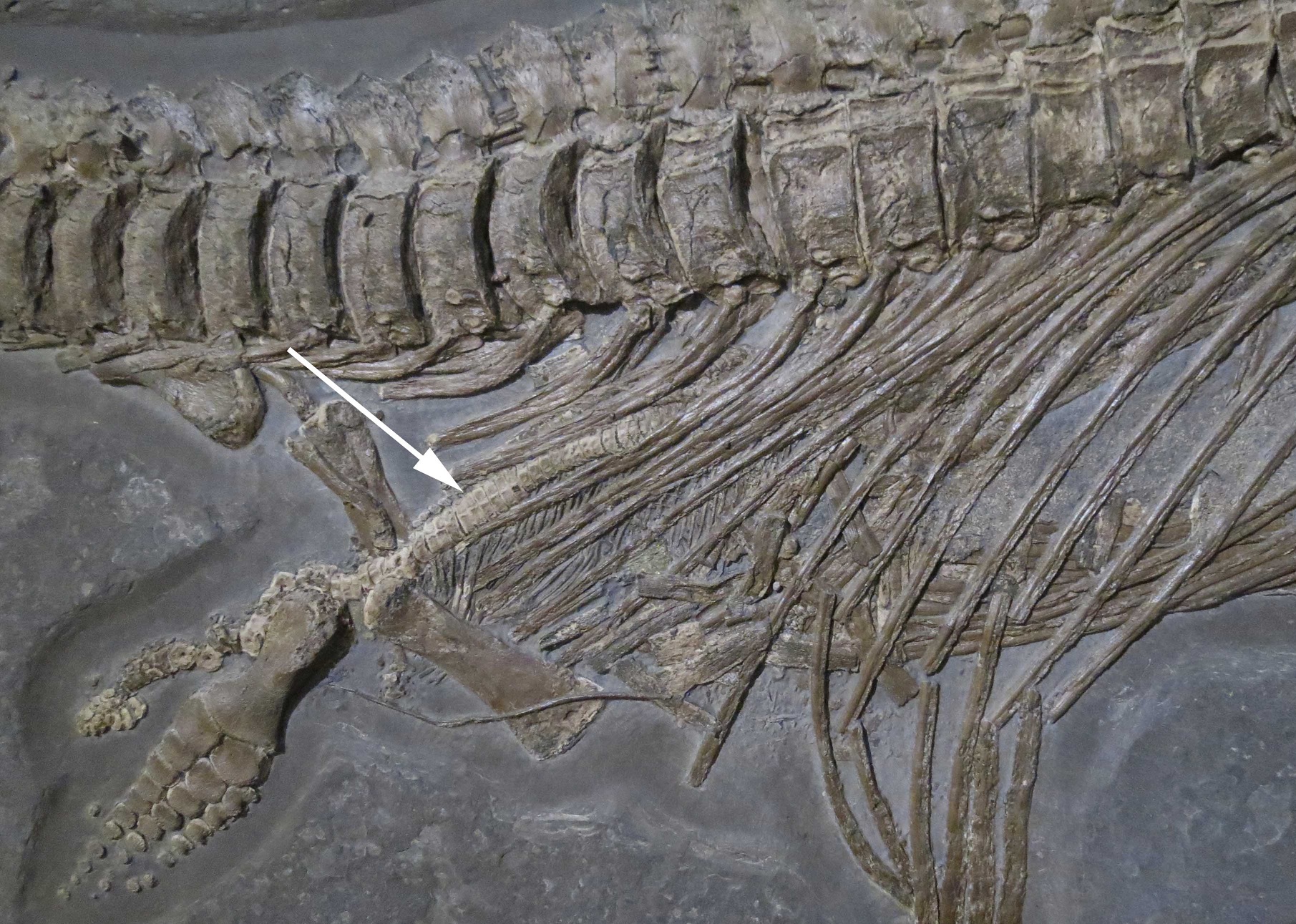
One thing that palaeontologists would really like to work out – me included – is exactly where ichthyosaurs come from, as in who their direct ancestors were. However, we do know that the first ichthyosaurs appeared around 248 million years ago, at the beginning of the Triassic Period. All of these early forms sort of looked like lizards with flippers and include the likes of Chaohusaurus from China (Figure 5), which was less than one metre in length, and the larger, 2-3 metre long Utatsusaurus from Japan. Studies of these early species help to shed some light on where the ichthyosaurs sit on the reptile tree of life, but we are still searching for that missing piece of the puzzle early on in their evolution.

The hupehsuchians are long-jawed marine reptiles from the Early Triassic of China (Figure 6). If you looked at one of their fossils, I would not blame you for assuming it was an ichthyosaur, or ichthyosaur ancestor, because there are some features shared in common with Early Triassic ichthyosaurs that they were contemporaneous with. However, this group, along with two rather interesting and recently described fossils, also from the earliest Triassic of China, called Cartorhynchus and Sclerocormus, lack key features of ichthyosaurs and are instead early ichthyosaur relatives . The intriguing thing is that these, unlike ichthyosaurs, were most probably semi-aquatic. What this shows is that a variety of new, unusual and diverse marine reptiles burst on to the scene and evolved rapidly following the world’s greatest mass extinction ever, the Permo-Triassic extinction event at 252 Ma.

Another group of small aquatic reptiles called mesosaurs, although from the Permian Period, may also have been semi-aquatic (Figure 7). These are the earliest-known secondarily aquatic tetrapods and so are an important group in helping to understand why terrestrial animals return to the sea. Some researchers have postulated that mesosaurs may also be related to ichthyosaurs .
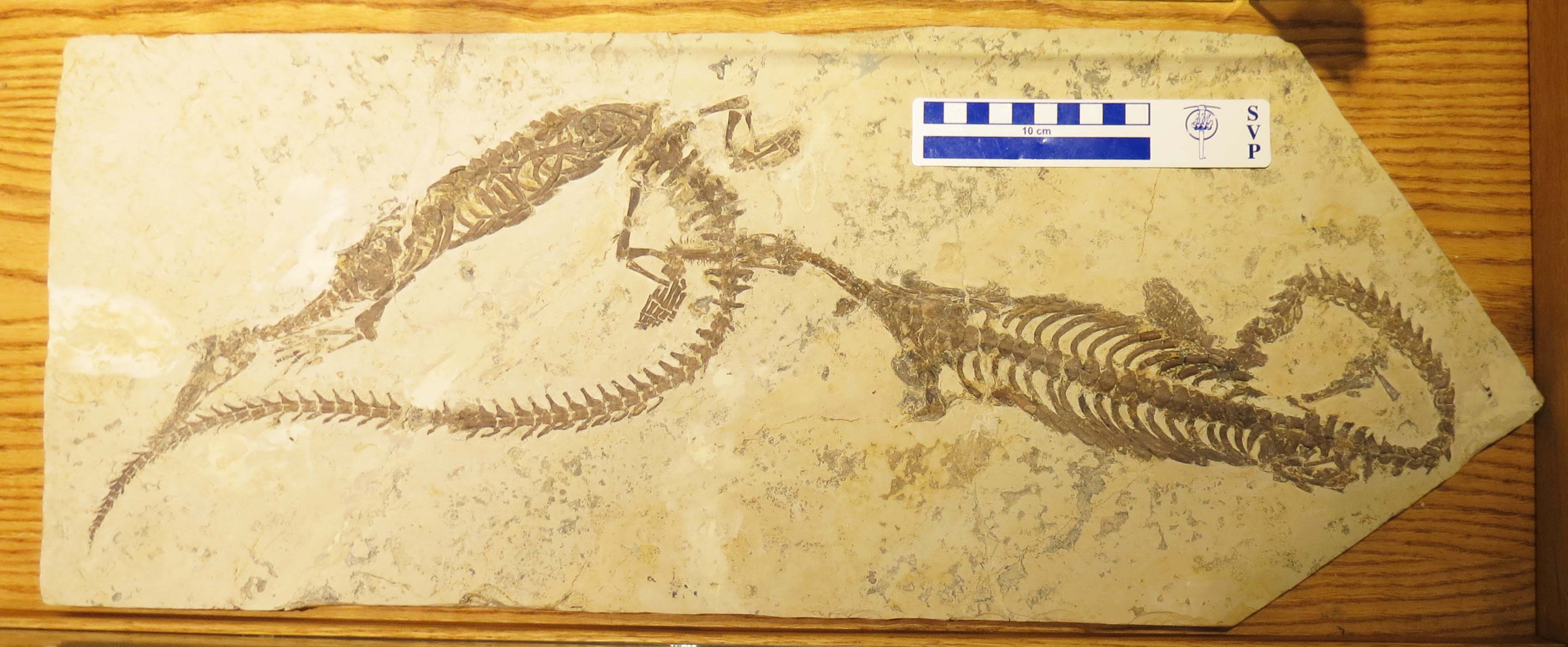
Of course, as is always the case in palaeontology, we need more fossils to help us understand how all of these early marine reptiles are related to one another.
A dolphin or a shark?
Although they superficially have a similar shape and they exploit similar environmental niches, we know that ichthyosaurs are reptiles and thus they are not dolphins (mammals) nor sharks (fish). However, what about their body shapes? Although ichthyosaurs were air breathers, meaning they still needed to come to the surface of the water to breathe like whales and dolphins, they were particularly well-adapted for life at sea. Their fins were so modified that they were unable to leave the water and no ichthyosaurs were capable of walking on land. Even the earlier, more primitive forms, those “lizards with flippers”, were good swimmers, although they swam in a similar fashion to eels. It was the later forms of ichthyosaur that evolved the now iconic fish-shaped bodies (Figure 8) that have become stereotypical of the group and is reflected in their name; ichthyosaur literally translates to “fish lizard”. Although fish come in all shapes and sizes and ichthyosaurs are often specifically compared with sharks. However, for anybody who knows anything about sharks, they also come in many different shapes, so the shark body comparison should be restricted to species like the great white, which are a good analogue with these later ichthyosaurs.
The obvious similarities between dolphins, sharks and ichthyosaurs epitomises the process of convergent evolution. This is when entirely unrelated animals independently evolve similar advantageous features as a result of having to adapt to similar environmental niches (Figure 8). This shared body shape is so well-adapted to life at sea that all these animals are capable of moving swiftly through the water. A very important feature when you want to be an effective predator, or you want to avoid being prey.
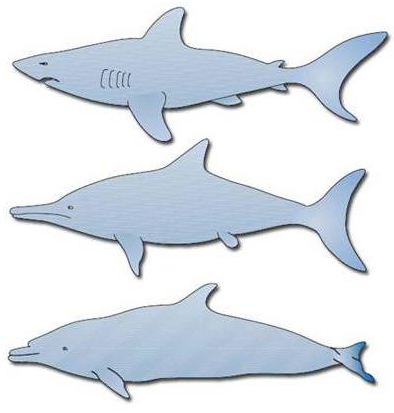
So, how did these later ichthyosaurs swim? First of all, no ichthyosaur had a tail fin (fluke) like a dolphin, which is horizontal and is used in an up and down motion to swim through the water. Instead, these ichthyosaurs had a vertical, crescent-like tail fin, which they used to swim by beating their tails in a side-to-side motion like fish. The identification of this tail fin, which is mostly made of soft tissue, was discovered in several specimens of the Early Jurassic ichthyosaur, Stenopterygius. Numerous beautiful specimens from Holzmaden, Germany, have been found with body outlines, including of the tail fluke and a dorsal fin (Figure 9), the latter of which probably acted as a stabilizer or a rudder. Interestingly, prior to this discovery, specimens that were found with a characteristic “kink” near the end of the tail, which actually signified the tail bend where the vertebral column was present in the lower lobe of the fluke, were thought to be damaged and so collectors often broke and straightened the tail!

All ichthyosaurs possessed a pair of forefins and hindfins that were essentially used for manoeuvring whilst swimming. Their forefins are particularly unusual. Some ichthyosaurs reduced their number of digits (digit = finger), whereas others increased their number of digits (hyperdactyly), and some species even had more than 30 phalanges in a single digit (hyperphalangy). Comparatively, in most ichthyosaurs the hindfin is smaller than the forefin, even twice as small in some species, but they were not quite as extreme as the forefin in terms of numbers of elements or digits. However, it might surprise you to read that ichthyosaurs actually had hindfins, considering that cetaceans and even sirenians have lost theirs through evolution. It is intriguing that these animals lost their hindfins in what is actually a relatively short period of time during their transition from land to sea, yet ichthyosaurs retained them for their entire reign . Simply, it was a case of “if you don’t use it, you lose it”. Considering that ichthyosaurs did not lose their hindfins shows that they clearly served a purpose (manoeuvring), as mentioned above, and it is likely that there was another function, which may have been for positioning during mating . In addition, through evolution, the pelvis in cetaceans and sirenians has been reduced to vestigial bones that have lost their contact with the vertebral column, which is also similar to ichthyosaurs. However, in ichthyosaurs the pelvis acted as an anchor point for the hindfin.
Ichthyosaurs were also the first tetrapods to reach truly gigantic sizes. For this reason, large whales are also good ichthyosaur analogues, although no ichthyosaurs were filter feeders like baleen whales. The largest ichthyosaurs belong to the family Shastasauridae, which first appeared during the Middle Triassic, around 240 million years ago. The largest species on record is the giant Shonisaurus sikanniensis, which was collected from British Columbia, Canada, and described in 2004 (Figure 10) . This giant lived about 215 million years ago and has a maximum estimated length of 21 metres – it was huge.
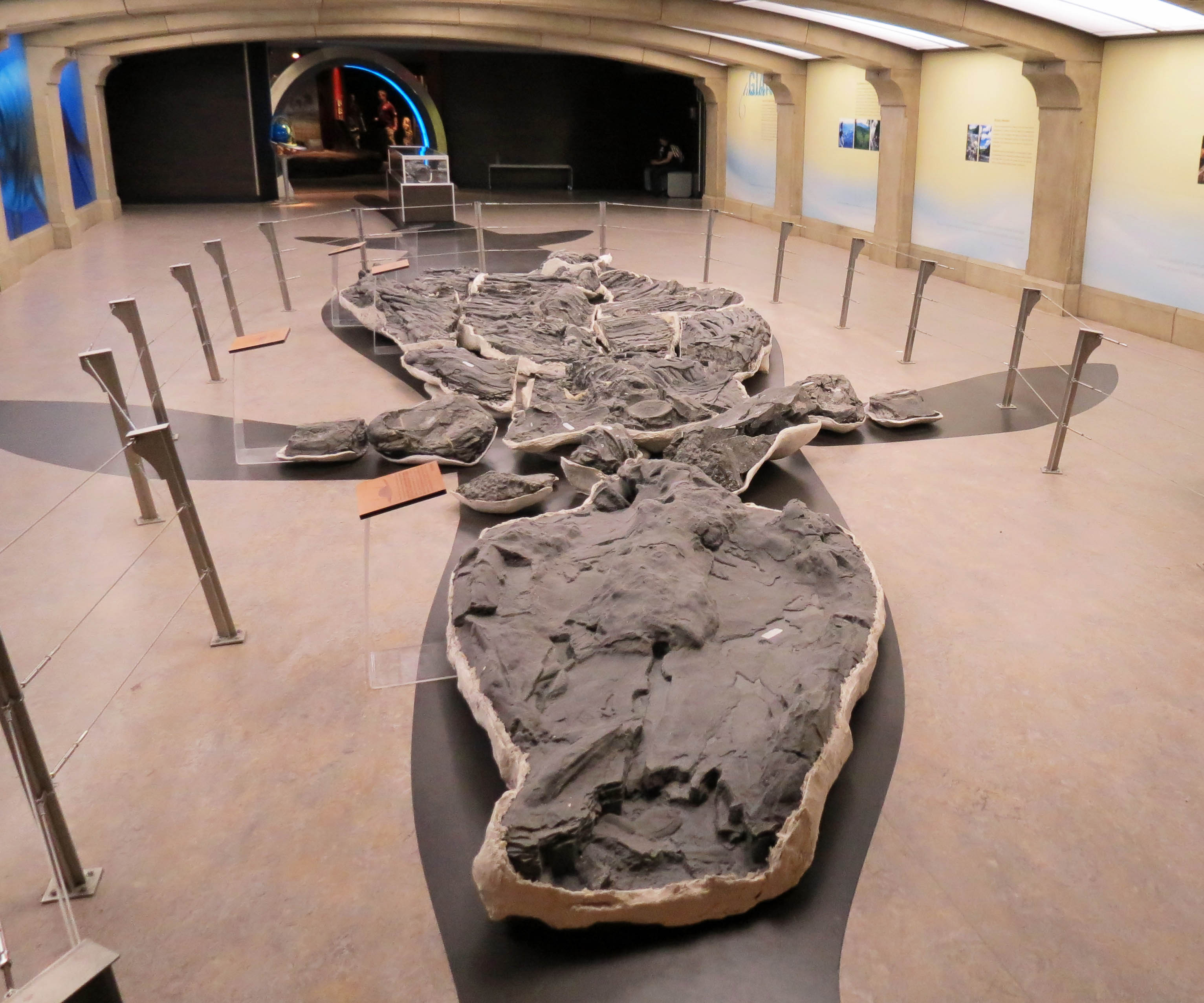
In one of my recent studies in collaboration with a team of experts we described a giant piece of ichthyosaur jaw collected from Somerset, England, which is about 205 million years old . Due to its fragmentary nature, we were unable to assign the jaw to a particular species. We suggested, however, that this bone belonged to an animal with a total estimated body length of up to 26 metres, around the average size of a blue whale. As part of this study, we also re-examined several giant bones collected over 150 years ago from a famous fossil site in the UK, known as Aust Cliff in Gloucestershire. These bones, which were previously identified as the limb bones of dinosaurs or some other terrestrial reptile, are in fact jaw fragments from other, giant ichthyosaurs. Size estimates suggest these particular individuals may have grown up to 30 metres or more – a contender for the largest animal that ever lived. However, because we are dealing with fragments and not complete skeletons, we have to be careful with these estimates as we are unable to quantify differences between species and individuals. Thus, as ever, we need to find more fossils and I hope that one day a complete giant ichthyosaur skeleton will be discovered.
Feeding time
Ichthyosaurs were well equipped predators. Tooth form varies among species, with some bearing delicate teeth for piercing, and others possessing more robust teeth for cutting and grasping prey. Based upon the preserved stomach contents found in many ichthyosaur species, the first of which were reported over 180 years ago, we know that they were partial to dining on squid-like cephalopods and fish. Usually, tiny arm hooklets from squid, or sometimes fish scales, are present between the ribs, often in great number (Figure 11). In rarer cases, smaller ichthyosaurs – which are not embryos – have been found as stomach contents in larger specimens and even hatchling turtles and a bird were found in one specimen. Coprolites that may have been produced by ichthyosaurs sometimes contain fragments of bone, teeth and scales and provide additional evidence of their diet.

As we have good information about their prey preference, is there, then, a correlation between what they were eating and how they were hunting? The first thing to do is look at an ichthyosaur skull (see Figure 2). What you will notice almost immediately is just how large the orbit is. Often, preserved inside this opening is a ring of bone resembling a pineapple slice, called the sclerotic ring. This bone was literally embedded within the eyeball. Thus, by measuring these bones, we can deduce the actual size of the eye and in short, their eyes were truly enormous. In fact, ichthyosaurs have the largest eyes of any vertebrate animal – living or extinct – and the largest recorded eye was bigger than a football ! These large eyes were capable of absorbing more light, which suggests they had good vision in low-light environments, indicating that they could hunt in deep, dark water .
By comparison, giant and colossal deep-sea squid (Architeuthis dux and Mesonychoteuthis hamiltoni, respectively) also have enormous eyes (Figure 12) and they use their light-sensitive eyes for detecting not only prey but also approaching sperm whales . Whales dive to great depths, sometimes up to several thousand metres, in search of their chosen food source, although they rely on echolocation instead of large eyes for detecting deep water prey (an example of non-convergent evolution). Therefore, considering that ichthyosaurs had a particular taste for squid, all lines of evidence suggest that ichthyosaurs were vision-guided predators, diving deep to catch their favoured prey as well, occupying a similar ecological niche filled by today’s sperm whales and beaked whales.

Additionally, studies undertaken on Jurassic and Cretaceous ichthyosaurs have shown that they may have been homeothermic, which would have allowed ichthyosaurs to overcome the sudden drop in water temperature when diving .
Of course, when you are an air breather, there are potentially deadly repercussions for hunting at great depths. If you get the dive wrong and run out of oxygen you could drown, but also predators may be lurking in the dim conditions – so having large eyes can also assist in predator detection. Such situations call for emergency surfacing, where return to the water’s surface must happen immediately. This, however, can lead to a dangerous physiological problem called decompression syndrome, or “the bends”, which is a result of resurfacing too quickly after a dive. Ultimately, this can result in a bone tissue-destroying condition called avascular necrosis, the symptoms of which have indeed been reported in several ichthyosaur specimens . Although many ichthyosaurs were affected by the bends, it was something else entirely that led to their eventual extinction.
Mysterious extinction – what happened?
Today, the only reptiles that spend much of their time in marine environments are the sea turtles, sea snakes, saltwater crocodile and marine iguana – they are, in essence, the only living marine reptiles . This is a far cry from the prehistoric seas that were once dominated by ichthyosaurs and various other marvellous prehistoric marine reptiles – plesiosaurs, pliosaurs, mosasaurs and placodonts etc. So, why is it that the ichthyosaurs, which were so well adapted to life at sea, became extinct so abruptly?
Ichthyosaurs were very successful and flourished throughout the Triassic, Jurassic and Early Cretaceous geological periods for about 155 million years. That is a long time, even in geological terms. Then, somewhat mysteriously, during the early Late Cretaceous (or “middle Cretaceous”), specifically the Cenomanian stage – boom, they were gone. No more ichthyosaurs. This was roughly 30 million years before the big extinction event that wiped out the non-bird dinosaurs (T. rex and co) at the end of the Cretaceous Period, 66 million years ago. Due to the apparent lack of ichthyosaur fossils from the mid Cretaceous, it was assumed that the group was declining, heading in only one direction – extinction. This, however, has recently been shown to be incorrect and in fact the opposite was happening. Ichthyosaur diversity still remained high right up until their extinction .
For a very long time, the best theory surrounding their extinction centred around competition from other predators, namely advanced sharks and other marine reptiles that were encroaching on the ichthyosaurs’ territory. In addition, a series of extinction events during the Cenomanian also effected marine life. All of this may very well have played a part in the demise of the ichthyosaurs, but over the last few years, new research has shed more light on this question.
This work has been led by one of my colleagues, Valentin Fischer of the University of Liège, Belgium. I have known Valentin for about seven years, after meeting him at a palaeontology conference and spending time with him studying ichthyosaurs at the Natural History Museum, London. He and his team built upon previous studies and found that the extinction events during the Cenomanian, coupled with environmental changes due to global warming led to the disappearance of the ichthyosaurs . Naturally, there are still many questions that need to be answered, like why other large marine reptiles managed to survive, whereas the ichthyosaurs did not . As ever, in years to come, we’ll have more fossils to examine, have more answers and, inevitably, more questions.
From kick-starting global excitement in palaeontology to being the first animals that evolved truly gigantic size, ichthyosaurs are one of the most remarkable and important fossil groups. It is no wonder that Mary Anning, who began this journey, was so captivated by these awe-inspiring “fish lizards” (Figure 13).

Acknowledgments
I would like to thank Nigel Larkin who kindly reviewed and provided comments on an earlier version of this article. Thanks also to Prof. Judy Massare and Bill Wahl for guidance over the past decade.
Further reading on this topic:
- McGowan C and Motani R (2003) Handbook of Paleoherpetology, Ichthyopterygia Verlag Dr. Friedrich Pfeil, Munich
- Motani R (2000) Rulers of the Jurassic Seas Scientific American 283: 52-59
 Paleobiology
Paleobiology
Responses